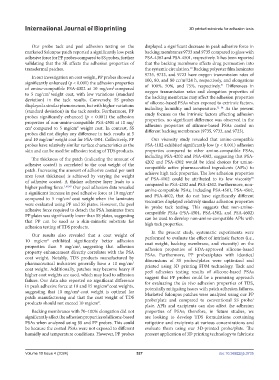Page 535 - IJB-10-4
P. 535
International Journal of Bioprinting 3D printed substrate for adhesion tests
Our probe tack and peel adhesion testing on the displayed a significant decrease in peak adhesive force in
marketed Salonpas patch reported a significantly low peak backing membranes 9733 and 9735 compared to glass with
adhesive force for PP probes compared to SS probes, further PSA-4302 and PSA-4501, respectively. It has been reported
validating that the SE affects the adhesion properties of that the backing membrane affects drug permeation into
transdermal patches. the systemic circulation. Backing polyester film laminates
50
In our investigation on coat weight, PP probes showed a 9735, 9733, and 9723 have oxygen transmission rates of
2
significantly enhanced (p < 0.001) the adhesion properties 100, 80, and 80 cc/m /24 h, respectively, and elongations
51
of amine-compatible PSA-4302 at 10 mg/cm compared of 100%, 50%, and 75%, respectively. Differences in
2
to 5 mg/cm weight coat, with low variations (standard oxygen transmission rates and elongation properties of
2
deviation) in the tack results. Conversely, SS probes the backing membrane may affect the adhesion properties
displayed a similar phenomenon, but with higher variations of silicone-based PSAs when exposed to extrinsic factors,
52–54
(standard deviation) in the tack results. Furthermore, PP including humidity and temperature. As the present
probes significantly enhanced (p < 0.001) the adhesion study focuses on the intrinsic factors affecting adhesion
properties of non-amine-compatible PSA-4501 at 10 mg/ properties, no significant difference was observed in the
adhesion properties of silicone-based PSAs coated on
cm compared to 5 mg/cm weight coat. In contrast, SS different backing membranes (9735, 9733, and 9723).
2
2
probes did not display any difference in tack results at 5
and 10 mg/cm weight coat for PSA-4501. Collectively, PP Our viscosity study revealed that amine-compatible
2
probes have relatively similar surface characteristics as the PSA-4102 exhibited significantly low (p < 0.001) adhesion
skin and can be used for adhesion testing of TDS products. properties compared to other amine-compatible PSAs,
including PSA-4202 and PSA-4302, suggesting that PSA-
The thickness of the patch (indicating the amount of
adhesive coated) is correlated to the coat weight of the 4202 and PSA-4302 would be ideal choices for amine-
compatible active pharmaceutical ingredients (APIs) to
patch. Increasing the amount of adhesive coated per unit achieve high tack properties. The low adhesion properties
area (coat thickness) is achieved by varying the weight of PSA-4102 could be attributed to its low viscosity
55
of adhesive coated. A thicker adhesive layer leads to a compared to PSA-4202 and PSA-4302. Furthermore, non-
higher peeling force. 1,48,49 Our peel adhesion data revealed amine-compatible PSAs, including PSA-4501, PSA-4502,
a significant increase in peel adhesive force at 10 mg/cm and PSA-4602, that do not have significantly different
2
compared to 5 mg/cm coat weight when the laminates viscosities displayed relatively similar adhesion properties
2
were evaluated using PP and SS plates. However, the peel in probe tack testing. This suggests that non-amine-
adhesive force required to detach the PSA laminates from compatible PSAs (PSA-4501, PSA-4502, and PSA-4602)
PP plates was significantly lower than SS plates, suggesting can be used to develop non-amine-compatible APIs with
that PP can be used as a skin-mimetic substrate for high tack properties.
adhesion testing of TDS products.
In the present study, systematic experiments were
Our results also revealed that a coat weight of
10 mg/cm exhibited significantly better adhesion performed to evaluate the effect of intrinsic factors (i.e.,
2
coat weight, backing membrane, and viscosity) on the
properties than 5 mg/cm , suggesting that adhesion adhesion properties of FDA-approved silicone-based
2
property enhancement directly correlates with the PSA PSAs. Furthermore, PP probes/plates with identical
coat weight. Notably, TDS products manufactured by dimensions of SS probes/plates were optimized and
pharmaceutical industries generally have a 10 mg/cm 2 printed using 3D printing FDM technology. Tack and
coat weight. Additionally, patches may become heavy if peel adhesion testing results of silicone-based PSAs
higher coat weights are used, which may lead to adhesion suggest that PP probes could be a promising approach
failure. Our data also reported no significant difference for evaluating the in vivo adhesion properties of TDS,
in peak adhesive force at 10 and 15 mg/cm coat weights, potentially mitigating issues with patch adhesion failures.
2
suggesting that 10 mg/cm coat weight is optimal for Marketed Salonpas patches were analyzed using our PP
2
patch manufacturing and that the coat weight of TDS probe/plate and compared to conventional SS probe/
products should not exceed 10 mg/cm .
2
plate. APIs and excipients can also affect the adhesion
Backing membranes with 70–100% elongation did not properties of PSAs; therefore, in future studies, we
significantly affect the adhesion properties of silicone-based are looking to develop TDS formulations containing
PSAs when analyzed using SS and PP probes. This could rotigotine and excipients at various concentrations and
be because the coated PSAs were not exposed to different evaluate them using our 3D-printed probe/plate. The
humidly and temperature conditions. However, PP probes present application of 3D printing technology to fabricate
Volume 10 Issue 4 (2024) 527 doi: 10.36922/ijb.3735

